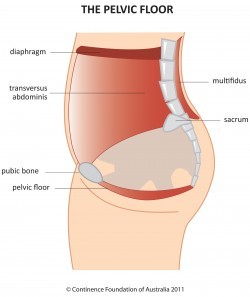 It's time to tackle the secret muscle. The pelvic floor is a complex of muscles, tendons, ligaments and fascia that forms a hammock in the base of the pelvis to support the internal organs, although it is perhaps best known for its role in sexual and urinary function. The pelvic floor has a tough job - it needs to work constantly to support our insides while we are upright, but also be able to relax sufficiently to allow for sexual intercourse, the passage of waste products and even childbirth. The pelvic floor is made of postural muscle - meaning that it can work for many hours without tiring. When a person walks, for example, the pelvic floor will naturally hold a certain amount of tension - without the need for conscious control. As a link between the front and rear of the body, it is also involved in maintaining the angle of the pelvis, and in turn its ability to hold and release tension is affected by its angle. Correct alignment through good posture both in your daily life and during exercise is therefore important for your pelvic health.  You should avoid holding the breath during exercises involving core work. The action of the pelvic floor mirrors that of the diaphragm during breathing. Breath holding can cause downward pressure (as shown in the diagram on the left) which bears down on the pelvic floor, and can stretch and strain the tissues. If there is a muscle imbalance during core exercises, the pelvic floor can be overpowered by the pressure created by the stronger muscles and the same problem of bearing down occurs. Constant bracing of the pelvic floor can also lead to the muscles becoming overly tight, so it also needs to be allowed to release. Weak pelvic floor muscles can lead to incontinence and organ prolapse. Some people have weakness from an early age, whereas others find that it happens at a particular life stage, such as pregnancy, or the menopause. However, it is worth noting that incontinence is NOT a normal part of ageing and should always be referred to a medical professional. On the other hand, overly tight pelvic floor muscles can lead to urinary urgency, constipation, unexplained pain in the pelvic area and pain during sexual intercourse. Excessive tightness can be caused by chronic stress - both of the anxiety type (just as your jaw tightens under stress, so can your pelvic floor) and the physical type - running, jumping etc. - and poor posture, especially when seated. In Pilates, there are no exercises to specifically work the pelvic floor (such as kegel exercises). Rather, the pelvic floor muscles are used for natural muscular support for movement. This sustained engagement of the muscles reflects the demand placed on them as postural muscles. By being aware of your pelvic floor, and allowing it to respond naturally to appropriate loads placed on it, and by emphasizing correct pelvic alignment, practicing Pilates can help to maintain optimal tone in your pelvic floor. However, Pilates performed with excessive effort and without mindfulness of the pelvic floor may exaggerate the problems associated with either excessively weak or tight pelvic floor muscles, and if you suffer from pelvic floor dysfunction, it is essential to consult a specialist physiotherapist or doctor. Comments are closed.
|
AuthorFitness and Pilates instructor with a passion for science. Archives
November 2021
Categories |
 RSS Feed
RSS Feed
